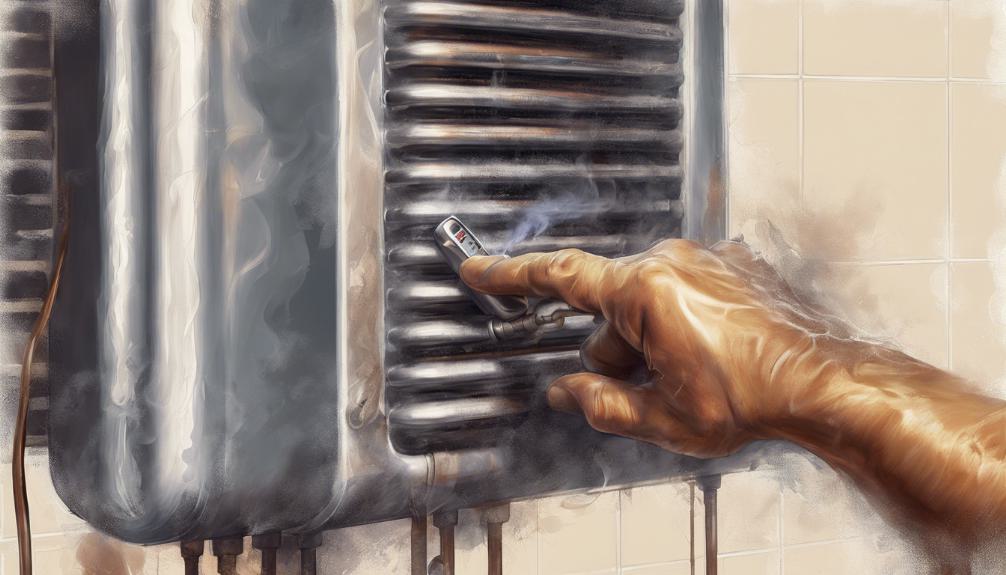Your car’s radiator typically runs between 200 to 250 degrees Fahrenheit, aiding in efficient heat dissipation. Monitoring this temperature is crucial to gauge cooling system efficacy and avoid engine overheating.
Excessive heat could lead to engine issues and system failures. To maintain peak operation, aim for radiator temperatures in the 180 to 200 degrees range.
Signs of trouble include leaks, discolored coolant, odd noises, or overheating.
Regular maintenance like cleaning fins, checking hoses, and using quality coolant with the right proportions can help avert costly problems.
Understanding these aspects safeguards your car’s engine performance and longevity.
What You Need to Know
- Radiators typically operate at temperatures between 200 to 250 degrees Fahrenheit.
- High temperatures show effective heat dissipation in the cooling system.
- Consistently low temperatures may indicate underlying cooling issues.
- Optimal radiator temperatures range from 180 to 200 degrees Fahrenheit.
- Maintaining proper temperatures prevents engine damage and ensures peak performance.
Importance of Monitoring Radiator Temperature

Monitoring your car’s radiator temperature is a critical task to prevent engine overheating and potential damage.
Temperature fluctuations in the radiator can indicate how well your cooling system is performing.
Radiators typically operate at temperatures ranging from 200 to 250 degrees Fahrenheit during normal conditions. These high temperatures are a sign that the cooling system is effectively dissipating heat from the engine.
However, if you notice consistently low radiator temperatures, it could signify issues with the cooling performance or insufficient heat transfer.
Effects of Overheating on Cooling System
If your car’s cooling system overheats, potential damage to the engine components can occur due to excessive heat exposure.
When the engine surpasses its ideal operating temperature, it can lead to engine damage and compromised cooling efficiency.
The high temperatures can cause the coolant to boil, forming steam pockets that disrupt proper coolant circulation.
In severe cases of overheating, the radiator can exceed temperatures of 200 degrees Fahrenheit, affecting its ability to cool the engine effectively.
Overheating isn’t just a minor issue; it can trigger the engine’s temperature warning light, indicating a critical situation that requires immediate attention to prevent serious damage.
Continual overheating can even result in radiator warping or cracking, leading to coolant leaks and potential engine failure if left unresolved.
Monitoring your car’s temperature gauge and addressing any signs of overheating promptly can help prevent costly repairs and keep your engine running smoothly.
Optimal Operating Temperatures for Radiators

To ensure efficient cooling and peak engine performance, it’s essential to maintain radiators within a temperature range of 180 to 200 degrees Fahrenheit.
Temperature regulation is key to ensuring that the radiator operates at its best. This range allows for effective heat dissipation, preventing overheating that could potentially damage engine components.
When the radiator operates within these specified temperatures, it efficiently cools the engine, contributing to its overall performance.
Monitoring and regulating the temperature of the radiator is essential for the health of the cooling system. If the radiator operates above this range, the engine may overheat, leading to adverse effects.
Conversely, if the temperature falls below the recommended range, cooling becomes inefficient, affecting engine efficiency.
Ensuring that the radiator functions within the specified temperature range is necessary for maintaining the overall performance and longevity of your vehicle’s engine.
Heat dissipation is optimized when the radiator operates within the specified temperatures, allowing for the effective cooling of the engine.
Signs of Radiator Malfunction
Be vigilant for these common indicators of radiator malfunction to prevent potential engine damage.
Coolant leaks are a red flag that your radiator may be failing; address them promptly to avoid overheating.
Discolored coolant or the presence of sludge in your radiator can signal internal issues that require immediate attention.
Strange noises coming from the radiator area are often a sign of impending problems that shouldn’t be ignored.
Then, overheating is a clear symptom of radiator malfunction and should be investigated promptly to prevent further damage to your engine.
Bent or damaged fins on the radiator can hinder proper heat dissipation, leading to overheating as well.
Common causes of radiator issues include worn-out hoses, a malfunctioning thermostat, or a failing water pump.
When faced with radiator problems, repair options may range from simple fixes like replacing a hose to more complex solutions such as repairing or replacing the entire radiator unit.
Regular maintenance and inspections can help catch these issues early and prevent costly repairs down the road.
Tips for Maintaining Radiator Efficiency

Regularly inspecting and cleaning your radiator fins is essential for ensuring maximum heat dissipation efficiency. To maintain your radiator’s efficiency, follow these tips:
- Inspect and Clean Fins: Check the radiator fins for any debris or blockages that could hinder airflow. Use a soft brush or compressed air to gently clean them, ensuring proper heat dissipation.
- Check for Leaks: Regularly inspect radiator hoses for leaks or cracks. Replace any damaged hoses promptly to prevent coolant loss, which can lead to overheating and enhanced efficiency.
- Choose Quality Coolant: Use a high-quality coolant with the correct mixture ratio. This helps maintain enhanced heat transfer properties within the radiator, enhancing its overall efficiency.
As an Amazon Associate we earn from qualifying purchases.










